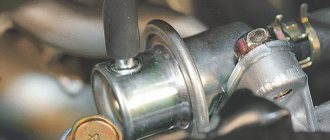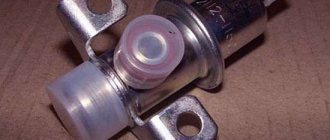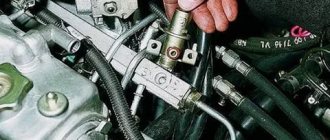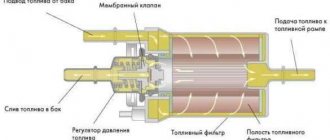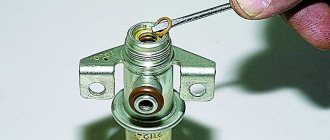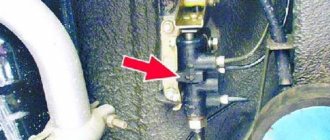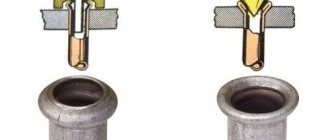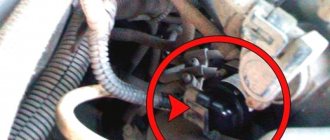The control system of a car engine contains a certain mathematical model, where output values are calculated based on measurements of input values. For example, how long the injectors open depends on the amount of air and many other variables. But besides them, there are also constants, that is, characteristics of the fuel system that are written in memory and cannot be controlled. One of them is the fuel pressure in the rail, or more precisely, its difference between the injector inlets and outlets.
Why do you need a fuel pressure regulator?
Fuel is supplied to the injectors from the tank by pumping it with an electric fuel pump located there. Its capabilities are redundant, that is, they are designed for maximum consumption in the heaviest mode plus a significant margin for deterioration of characteristics over time during long-term operation.
But the pump cannot constantly pump to the full power of its changing capabilities; the pressure must be limited and stabilized. For this purpose, fuel pressure regulators (FPR) are used.
They can be installed either directly in the pump module or on the fuel rail that supplies the injection nozzles. In this case, you have to dump the excess through the drain line (return) back into the tank.
Symptoms of element failure
"Check" light on the dashboard
The check may light up for various reasons, one of which may be a malfunction of the RTD. To more accurately identify a breakdown, it is recommended to use diagnostic equipment, in common parlance – an “auto scanner”. There are a very large number of similar devices on the market, but we recommend paying attention to the Korean-made scanner Scan Tool Pro Black Edition.
This scanner is in the budget segment, but at the same time it is capable of diagnosing not only the engine, but also other components of the car (srs, abs, esp, airbags, transmission, etc.). After diagnosing with its help, a fault with the RTD will be indicated by error code P0089. However, this error can also occur if the fuel grid, filter or fuel lines are clogged. Therefore, they should also be inspected, and then proceed to a detailed inspection of the RTD.
Two types of RTD failure
During the operation of the car, a car owner may encounter two types of RTD failure:
- The pressure drop in the rail is below the permissible level - the regulator directs most of the fuel through the return line to the gas tank.
- Increase in pressure to maximum - the element does not allow fuel to flow into the return line.
Note. As a rule, the first malfunction is accompanied by a rapid drop in pressure in the system after the electric fuel pump is turned off.
It is quite simple to track the signs of the first malfunction - the power unit is sorely lacking fuel for normal operation in all modes. Symptoms appear as follows:
- cold starting is difficult, the engine runs extremely unstable until it warms up;
- “dips” during acceleration and jerks when moving uphill;
- the car often stalls at idle;
- Gasoline consumption per 100 km increases.
The increased fuel consumption is explained by the actions of the driver trying to compensate for the lack of fuel mixture by pressing the accelerator pedal. Driving in this mode is quite difficult - it is better to immediately check the fuel pressure regulator for functionality.
When the valve does not allow excess fuel to flow into the tank, the following consequences are observed:
- Due to too high pressure from the ramp side, the injectors begin to leak and fill the cylinders with pure gasoline, and not with the working air-fuel mixture.
- The engine is bad, it emits black smoke from the exhaust, and sometimes you can hear popping noises in the exhaust manifold. The reason is flashes of unburnt fuel.
- Consumption increases noticeably.
- Leaks may be observed at the joints of the fuel pipes, and a strong gasoline smell may be felt.
Practical experience shows that a lack of fuel mixture occurs more often than an excess. That is, the most common problem with an RTD is the draining of gasoline into the return pipe and tank.
Device
The regulator can be mechanical or electronic. In the second case, this is a classic control system with a pressure sensor and feedback. But a simple mechanical one is no less reliable, and cheaper.
On the subject: How to find out the fuel consumption of a car by mileage (per 100 km)
The regulator installed on the ramp consists of:
- two cavities, one contains fuel, the other contains air vacuum from the intake manifold;
- elastic diaphragm separating the cavities;
- spring-loaded control valve connected to a diaphragm;
- housing with return fittings and a vacuum hose from the intake manifold.
Sometimes the RTD contains a mesh filter for coarse purification of passing gasoline. The entire regulator is installed on the ramp and communicates with its internal cavity.
How to repair an RTD?
As part of component repair, the following work must be performed:
- Look under the hood of the car where there is a fitting plug designed to control fuel pressure. Unscrew it, then using a special protective metal cap, carefully unscrew the spool inside the fitting.
- Connect the hose with the pressure gauge and secure it to the fitting using a clamp. After starting the engine, check that the pressure reading on the measuring device does not exceed 3.25 Bar.
- Disconnect the vacuum hose from the RTD. This operation should be accompanied by an increase in pressure. If nothing happens, repairing the fuel pressure regulator is useless; you will have to replace the element with a new one.
If the part cannot be repaired, we proceed to install a new device.
- Disconnect the vacuum hose. The pressure will begin to increase. Having reduced the pressure in the power system, proceed to remove the vacuum hose. You will need to unscrew the securing nut on the fuel drain pipe, where diesel or gasoline flows through the fuel filter to the RTD.
- After unscrewing the two bolts securing the device to the fuel rail, you can safely remove the regulator from the fuel discharge tube itself. The ring remaining in the ramp can be easily removed by hand and placed on the regulator before installation.
- Install a new regulator and perform all previous steps in reverse order. Make sure the new device is in working order, only then proceed with complete assembly. Upon completion of installation, perform a control check of the operation and serviceability of the device.
Principle of operation
To fix the pressure between the injector inlets and outlets, it is necessary to add to its value in the ramp a negative vacuum in the manifold, where the injector nozzles exit. And since the vacuum depth changes depending on the load and the degree of throttle opening, the difference must be monitored continuously, stabilizing the difference.
Only then will the injectors operate at their standard performance levels, and the composition of the mixture will not require deep and frequent correction.
As the vacuum at the RTD vacuum pipe increases, the valve will open slightly, releasing additional portions of gasoline into the return line, stabilizing the dependence on the state of the atmosphere in the manifold. This is an additional correction.
The main regulation occurs thanks to a spring that presses the valve. The main characteristic of the RDT – stabilized pressure – is standardized according to its rigidity. The work follows the same principle: if the pump presses too much, then the hydraulic resistance of the valve decreases, and more fuel is drained back into the tank.
Diagnostics
The serviceability of the fuel pressure regulator is checked by measuring the pressure in the fuel rail. Let's consider the algorithm for checking the pressure regulator using the example of a VAZ-2110 car with an injection power system. This car uses an injector with fuel recirculation, so the RTD is located on the fuel rail. To do this, you will need a pressure gauge, as well as a piece of oil-resistant rubber tube and two clamps. The algorithm of actions is as follows:
- We produce fuel from the ramp (we remove the fuse responsible for powering the electric fuel pump, start the engine and wait for it to stop voluntarily).
- On the ramp we find a fitting designed to relieve pressure and remove the cap on it.
- We unscrew the spool valve from the fitting (carefully and slowly, since fuel may remain in the ramp).
- We pull the tube onto the fitting and secure it with a clamp.
- We connect a pressure gauge to the tube and also fix it.
- We put the fuse back and start the engine.
- We install it on the XX motor.
- We check the pressure gauge readings (on the VAZ-2110 this parameter is 2.8-3.2 Atm.).
- We find the pipe coming from the manifold on the regulator and disconnect it from the RTD. If the device is working properly, this action will lead to an increase in pressure by 0.3-0.7 Atm.
Inconsistencies in pressure gauge readings will indicate a problem with the regulator or other system components. To accurately identify the cause of the malfunction, you need to diagnose the operation of other components.
Video: Fuel pressure regulator. It doesn't drive well, it doesn't start well.
The fuel line and the injector ramp that supplies the engine injectors operate under a pressure of about 3 bar. Since gasoline is supplied by an electric pump, the system uses a special valve that limits the fuel pressure. Otherwise, the nozzles will leak and the engine will choke on the over-enriched mixture. To avoid problems with fuel supply, you need to promptly diagnose the signs of a malfunction of the fuel pressure regulator (abbreviated as RTD) and know how to eliminate it.
Signs and symptoms of a malfunctioning RTD
Depending on the nature of the malfunction, the pressure can either increase or decrease. Accordingly, the mixture entering the cylinders becomes richer or leaner.
The control unit is trying to adjust the composition, but its capabilities are limited. Combustion is disrupted, the engine begins to work intermittently, flashes disappear, traction worsens, and consumption increases. And in any case, the mixture is lean or enriched. It burns equally badly.
Why is this necessary?
The main task of the RTD is to “monitor” the fuel pressure in the injectors of the power unit and maintain optimal pressure. No matter what the load on the engine, the regulator's job is to maintain the correct pressure. For example, as the speed increases, the pressure will increase. Otherwise, the engine will get a lean mixture . If the speed decreases and the pressure is too high, the unit will begin to consume an over-enriched mixture - too many shares of fuel will be used to prepare it.
One of the side functions of the RTD is compensation for excess pressure in the rack. This is especially important when the intake manifold passes small volumes of air, and the fuel pressure does not change - in this case, the control unit would simply change the timing of the fuel or mixture being sprayed. This compensates for excess pressure, but will negatively affect the dynamics of the car. More interesting cases are also possible. For example, in the case of gasoline units, the fuel will not burn completely and will flood the spark plugs. Result: increased consumption with unchanged power indicators, deterioration of the vehicle’s environmental performance, faster consumption of the catalyst’s life. The RTD in the rail or in the fuel tank (there is such an installation scheme) reacts to changes in pressure and, if necessary, redirects excess fuel to the tank.
How to check the device for functionality
To check, the pressure in the rail is measured. It is equipped with a valve to which a test pressure gauge can be connected. The device will show whether the value is within the normal range or not. And the specific fault of the regulator will be indicated by the nature of the reaction of the readings to opening the throttle valve and turning off the return line, for which it is enough to pinch or plug its flexible hose.
Removing the vacuum hose from the RTD fitting will also demonstrate the adequacy of the pressure response. If the engine was running at minimum speed, that is, the vacuum was high, then the disappearance of vacuum should cause an increase in pressure in the ramp. If not, the regulator is not working properly.
How to check the fuel rail? Checking the RTD yourself
Checking the fuel pressure regulator is carried out to identify malfunctions or for prevention. Such checks are carried out based on the recommendations of the car manufacturer. But still, how to check the pressure in the fuel rail? Basically, the check consists of inspecting and checking the pressure of the fuel system at various engine speeds. Then comparisons are made with indicators that correspond to the norm.
It is necessary to carefully inspect the tightness of the connections, the condition of the vacuum hose, as well as the regulator itself. If no damage or defects are found, then the regulator is dismantled by completely disassembling it. If a blockage is detected in this unit, it is washed.
Important: the pressure in the fuel rail should be diagnosed using a pressure gauge. It is connected to a special diagnostic fitting.
How to check the fuel pressure regulator. Fuel pressure regulator diagnostics
You can also check the regulator yourself. To do this, you do not need to use any special tools or have any special auto mechanic skills. You will need to pinch or disconnect the valve and observe the force of the jet. Or for a better check, use a pressure gauge.
To measure the RTD pressure in the engine when turning on idle speed, it is worth connecting a pressure gauge, installing it between the fuel hose and the fitting. Don't forget to disconnect the vacuum hose. Below we will look at what pressure should be in the fuel rail of a VAZ 2110.
When measuring the pressure in the fuel rail with your own hands, the pressure should begin to increase from 0.3 to as much as 0.7 Bar.
If the pressure remains in place, repeat the procedure. It happens that after a number of necessary procedures, the pressure remains the same. This means that the regulator is faulty and cannot be repaired. It needs to be replaced.
How do malfunctions of the fuel pressure regulator affect engine performance?
A faulty regulator valve affects not only operation, but also the very start of the engine.
If the device is working properly, the pressure in the fuel rail does not drop after the engine stops. If the valve has a malfunction, then the pressure in the fuel rail drops when the engine stops. The engine will not start until the sediment has completely filled the system. And only after reaching the desired level, the first engine start signals may appear. Here everything will depend on the power of the battery. Otherwise, the engine will not be able to start. Therefore, if the pressure in the fuel rail does not hold, this indicates a malfunction! In addition to the above, gas failures may occur during acceleration of the car, unstable idling, and a general weakening of engine power will begin to appear.
How to clean an RTD
The regulator cannot be repaired; if it malfunctions, it is replaced with a new one; the price of the part is low. But sometimes it is possible to restore functionality by cleaning the built-in mesh filter. To do this, the regulator is dismantled and washed with carburetor cleaner, followed by purging.
The operation can be repeated for better results. It is also possible to use an ultrasonic bath with a solvent, which is used to clean injectors, where similar problems arise due to dirty fuel.
There is no particular point in these procedures, especially if the part has already served a lot. The cost of time and money is quite comparable to the price of a new RTD, despite the fact that the valve in the old one is already worn out, the diaphragm is aged, and caustic cleaning compounds can cause final failure.
Diagnostics and malfunctions of the fuel regulator
All modifications of regulators have a non-separable design, so they cannot be repaired. In some cases, the part can be cleaned, but its service life does not increase much. When a part breaks, it is simply replaced with a new one.
Here are the main reasons for failure:
- The spring is broken;
- Formation of a fistula in the body (often due to exceeding the pressure threshold or mechanical damage);
- Natural wear and tear of moving elements;
- Corrosion formation;
- Clogged channels.
When diagnosing the device, you should remember that some symptoms are similar to fuel injection pump failures. It is also not uncommon for the fuel system to malfunction, the symptoms of which are very similar to a regulator failure. An example of this is clogged filter elements.
In order for this element to work out its intended life, it is very important to pay attention to the quality of the fuel used.
Instructions for replacing the fuel pressure regulator using the example of an Audi A6 C5
Access to the regulator on these machines is easy; it is installed on the fuel rail of the injectors.
- Remove the decorative plastic cover from the top of the engine by unscrewing the twist latches counterclockwise.
- Use a screwdriver to pry up and remove the retaining spring bracket on the regulator body.
- The vacuum hose is disconnected from the regulator fitting.
- The residual pressure in the rail can be relieved in various ways by letting the engine run with the fuel pump turned off, pressing on the spool of the pressure gauge valve on the rail, or simply disconnecting the halves of the regulator housing. In the last two cases, you need to use a rag to absorb the escaping gasoline.
- With the lock removed, the regulator is simply removed from the body, after which it can be washed, replaced with a new one, and everything reassembled in the reverse order.
Before installation, it is recommended to lubricate the rubber O-rings so as not to damage them when immersed in the socket.
What are the consequences of malfunctions in the operation of RDTs?
Over time, the engine starts more and more poorly. Fuel begins to come out of the cracks, which leads to a strong increase in its consumption. When the pressure changes unevenly, the dynamics of movement are disrupted, surges occur, and the car jerks during acceleration.
Is it possible to repair a failed part? In most cases, no, you have to completely change it. Repair units are almost always non-separable. Some experts suggest repairing the component, but this is dangerous. It is better to buy a new regulator - fortunately, it is inexpensive.
Determining violations in the operation of RTDs is not a very difficult task, which can be handled independently. Remember that this part of the machine needs to be checked periodically. By detecting the problem in time, you will protect important car components from rapid wear.
Operating principle of RTD
The valve design and operating principle depend on the type of fuel system of a particular vehicle. There are 3 ways to supply gasoline from the tank to the injectors:
- The pump together with the regulator is installed inside the tank; fuel is supplied to the engine through one line.
- Gasoline is supplied through one tube and returned through another. The fuel system check valve is located on the distribution rail.
- The circuit without a mechanical regulator provides for electronic control of the fuel pump directly. The system contains a special sensor that registers pressure; the pump performance is regulated by the controller.
